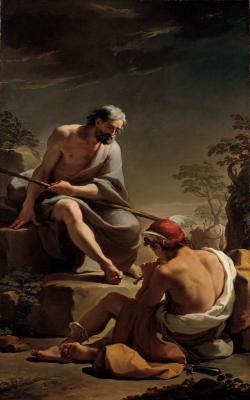
The Gandolfi family—Ubaldo, his brother Gaetano, and his nephew Mauro—were the last great painters of the Bolognese school, which rose to international prominence at the end of the sixteenth century. The confident understanding of human anatomy demonstrated in these paintings reveals Ubaldo’s debt to the Bolognese tradition, which was firmly based on drawing from live models.
Commissioned to adorn the walls of the Marescalchi family’s palace in Bologna, this and another painting in the North Carolina Museum of Art collection originally formed part of a series of six works illustrating classical myths. Io was a beautiful princess seduced by Jupiter, king of the gods. To conceal his infidelity from his wife, Juno, Jupiter changed Io into a white heifer. Suspicious, Juno cunningly asked for the heifer as a gift, a request that Jupiter could not very well refuse. His wife placed the heifer under the guard of the hundred-eyed giant Argus (whom Gandolfi wisely decided to depict with only two eyes). Sent by Jupiter to recover Io, Mercury lulled Argus to sleep with music and then cut off the giant’s head.
The two paintings illustrate consecutive moments in the story. Here, Mercury, wearing a winged cap and winged ankle bracelets, puts Argus to sleep by playing his flute. In the companion painting, Gandolfi represents the imminent dispatch of Argus with a touch of humor, as Mercury gestures for the viewer to be quiet so as not to wake the sleeping giant.

